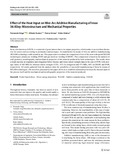Effect of the heat input on wire-arc additive manufacturing of invar 36 alloy: microstructure and mechanical properties
Fecha
2022Versión
Acceso abierto / Sarbide irekia
Tipo
Artículo / Artikulua
Versión
Versión publicada / Argitaratu den bertsioa
Impacto
|
|
10.1007/s40194-022-01295-4
Resumen
Invar, also known as FeNi36, is a material of great interest due to its unique properties, which makes it an excellent alternative for sectors such as tooling in aeronautics and aerospace. Its manufacture by means of wire arc additive manufacturing (WAAM) technology could extend its use. This paper aims to evaluate the comparison of two of the most widespread WAAM technologies: plasma arc welding ...
[++]
Invar, also known as FeNi36, is a material of great interest due to its unique properties, which makes it an excellent alternative for sectors such as tooling in aeronautics and aerospace. Its manufacture by means of wire arc additive manufacturing (WAAM) technology could extend its use. This paper aims to evaluate the comparison of two of the most widespread WAAM technologies: plasma arc welding (PAW) and gas metal arc welding (GMAW). This comparison is based on the analysis of wall geometry, metallography, and mechanical properties of the material produced by both technologies. The results show a slight increase in toughness and elongation before fracture and worse tensile strength data in the case of PAW, with average values of 485 MPa for ultimate tensile strength (UTS), 31% for elongation and 475 MPa, 40% in GMAW and PAW, respectively. All results gathered from the analysis show the possibility of successful manufacturing of Invar by means of WAAM technologies. The novelties presented in this paper allow us to establish relationships between the thermal input of the process itself and the mechanical and metallographic properties of the material produced. [--]
Materias
Additive manufacturing,
Direct energy deposition,
FeNi36,
Nickel-based alloys,
WAAM
Editor
Springer
Publicado en
Welding in the World, 2022, 66,pp. 1081-1091
Departamento
Universidad Pública de Navarra. Departamento de Ingeniería /
Nafarroako Unibertsitate Publikoa. Ingeniaritza Saila
Versión del editor
Entidades Financiadoras
Open Access funding provided by Universidad Pública de Navarra. The authors acknowledge funding from the Basque Government to the HARITIVE project [ZE-2017/00038], HARIPLUS project [ZE-2019/00352], QUALYFAM project [kk-2020/00042], and the European Institute of Innovation and Technology to DEDALUS project [reference ID 20094].






